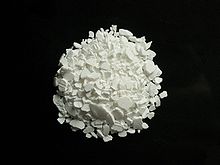
Back Kalsiumchloried Afrikaans كلوريد الكالسيوم Arabic Cloruru de calciu AST کولورید کلسیوم AZB Кальций хлориды Bashkir Калциев хлорид Bulgarian ক্যালসিয়াম ক্লোরাইড Bengali/Bangla Clorur de calci Catalan Chlorid vápenatý Czech Calsiwm clorid Welsh
 | |
 | |
| Names | |
|---|---|
| IUPAC name
Calcium chloride
| |
Other names
| |
| Identifiers | |
| |
3D model (JSmol)
|
|
| ChEBI | |
| ChEMBL | |
| ChemSpider | |
| DrugBank | |
| ECHA InfoCard | 100.030.115 |
| EC Number |
|
| E number | E509 (acidity regulators, ...) |
PubChem CID
|
|
| RTECS number |
|
| UNII |
|
CompTox Dashboard (EPA)
|
|
| |
| |
| Properties | |
| CaCl2 | |
| Molar mass | 110.98 g·mol−1 |
| Appearance | White hygroscopic powder |
| Odor | Odorless |
| Density |
|
| Melting point | 772–775 °C (1,422–1,427 °F; 1,045–1,048 K) anhydrous[5] 260 °C (500 °F; 533 K) monohydrate, decomposes 175 °C (347 °F; 448 K) dihydrate, decomposes 45.5 °C (113.9 °F; 318.6 K) tetrahydrate, decomposes[5] 30 °C (86 °F; 303 K) hexahydrate, decomposes[1] |
| Boiling point | 1,935 °C (3,515 °F; 2,208 K) anhydrous[1] |
| Anhydrous: 74.5 g/100 mL (20 °C)[2] Hexahydrate: 49.4 g/100 mL (−25 °C) 59.5 g/100 mL (0 °C) 65 g/100 mL (10 °C) 81.1 g/100 mL (25 °C)[1] 102.2 g/100 mL (30.2 °C) α-Tetrahydrate: 90.8 g/100 mL (20 °C) 114.4 g/100 mL (40 °C) Dihydrate: 134.5 g/100 mL (60 °C) 152.4 g/100 mL (100 °C)[3] | |
| Solubility |
|
| Solubility in ethanol |
|
| Solubility in methanol |
|
| Solubility in acetone | 0.1 g/kg (20 °C)[4] |
| Solubility in pyridine | 16.6 g/kg[4] |
| Acidity (pKa) |
|
| −5.47·10−5 cm3/mol[1] | |
Refractive index (nD)
|
1.52 |
| Viscosity |
|
| Structure | |
| |
| |
| |
a = 6.259 Å, b = 6.444 Å, c = 4.17 Å (anhydrous, 17 °C)[6] α = 90°, β = 90°, γ = 90°
| |
| Octahedral at Ca2+ centres (anhydrous) | |
| Thermochemistry | |
Heat capacity (C)
|
|
Std molar
entropy (S⦵298) |
108.4 J/(mol·K)[1][5] |
Std enthalpy of
formation (ΔfH⦵298) |
|
Gibbs free energy (ΔfG⦵)
|
−748.81 kJ/mol[1][5] |
| Pharmacology | |
| A12AA07 (WHO) B05XA07 (WHO), G04BA03 (WHO) | |
| Hazards | |
| Occupational safety and health (OHS/OSH): | |
Main hazards
|
Irritant |
| GHS labelling: | |
 [7] [7]
| |
| Warning | |
| H319[7] | |
| P305+P351+P338[7] | |
| NFPA 704 (fire diamond) | |
| Lethal dose or concentration (LD, LC): | |
LD50 (median dose)
|
1,000-1,400 mg/kg (rats, oral)[8] |
| Related compounds | |
Other anions
|
|
Other cations
|
|
Except where otherwise noted, data are given for materials in their standard state (at 25 °C [77 °F], 100 kPa).
| |
Calcium chloride is an inorganic compound, a salt with the chemical formula CaCl2. It is a white crystalline solid at room temperature, and it is highly soluble in water. It can be created by neutralising hydrochloric acid with calcium hydroxide.
Calcium chloride is commonly encountered as a hydrated solid with generic formula CaCl2·nH2O, where n = 0, 1, 2, 4, and 6. These compounds are mainly used for de-icing and dust control. Because the anhydrous salt is hygroscopic and deliquescent, it is used as a desiccant.[10]
- ^ a b c d e f g h i Lide DR, ed. (2009). CRC Handbook of Chemistry and Physics (90th ed.). Boca Raton, Florida: CRC Press. ISBN 978-1-4200-9084-0.
- ^ "Calcium chloride (anhydrous)". ICSC. International Programme on Chemical Safety and the European Commission. Archived from the original on 25 September 2015. Retrieved 18 September 2015.
- ^ Seidell A, Linke WF (1919). Solubilities of Inorganic and Organic Compounds (second ed.). New York: D. Van Nostrand Company. p. 196.
- ^ a b c d e f Anatolievich KR. "Properties of substance: calcium chloride". chemister.ru. Archived from the original on 24 June 2015. Retrieved 7 July 2014.
- ^ a b c d e f Pradyot P (2019). Handbook of Inorganic Chemicals. The McGraw-Hill Companies, Inc. p. 162. ISBN 978-0-07-049439-8.
- ^ a b c d Müller U (2006). Inorganic Structural Chemistry (second ed.). England: John Wiley & Sons Ltd. p. 33. ISBN 978-0-470-01864-4.
- ^ a b c Sigma-Aldrich Co., Calcium chloride.
- ^ Garrett DE (2004). Handbook of Lithium and Natural Calcium Chloride. Elsevier. p. 379. ISBN 978-0-08-047290-4. Archived from the original on 31 October 2023. Retrieved 29 August 2018.
Its toxicity upon ingestion, is indicated by the test on rats: oral LD50 (rat) is 1.0–1.4 g/kg (the lethal dose for half of the test animals, in this case rats...)
- ^ "MSDS of Calcium chloride". fishersci.ca. Fisher Scientific. Archived from the original on 25 September 2015. Retrieved 7 July 2014.
- ^ Robert Kemp, Suzanne E. Keegan "Calcium Chloride" in Ullmann's Encyclopedia of Industrial Chemistry 2000, Wiley-VCH, Weinheim. doi:10.1002/14356007.a04_547
